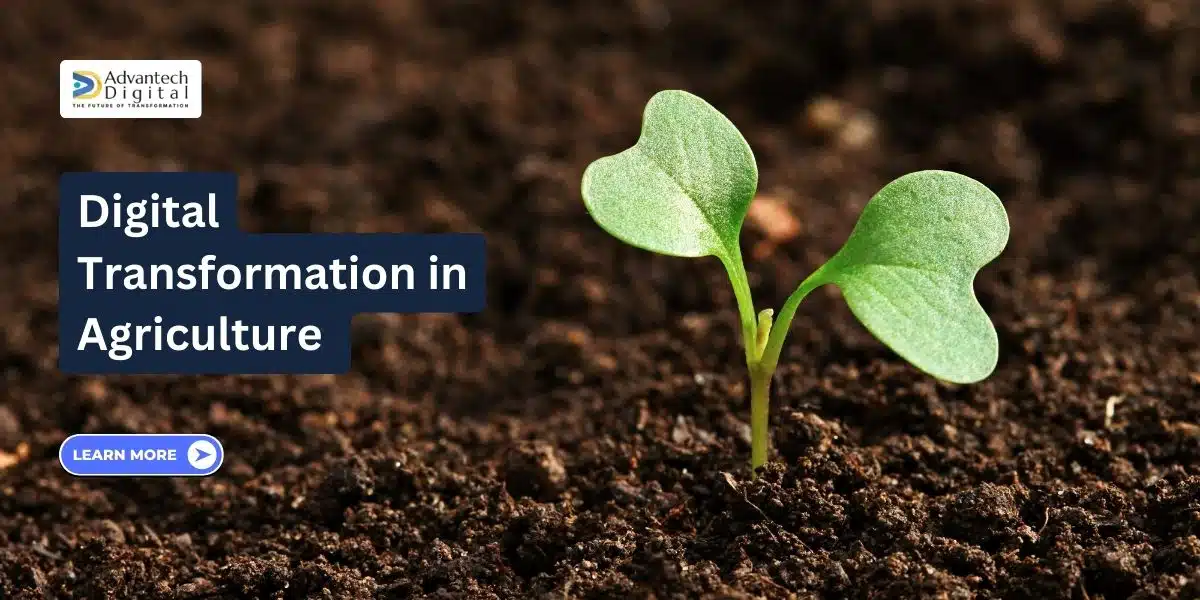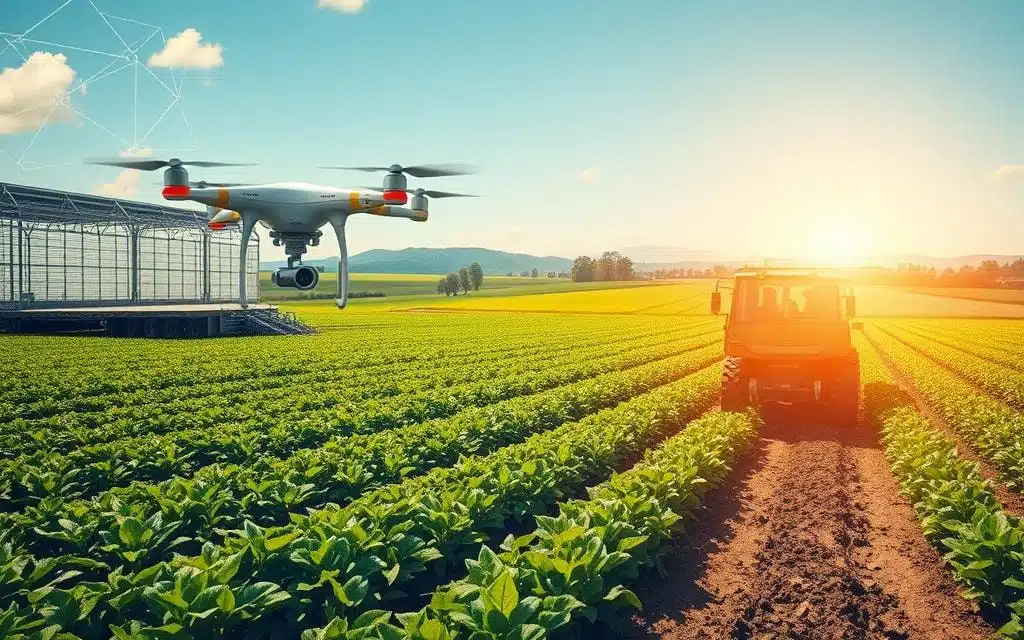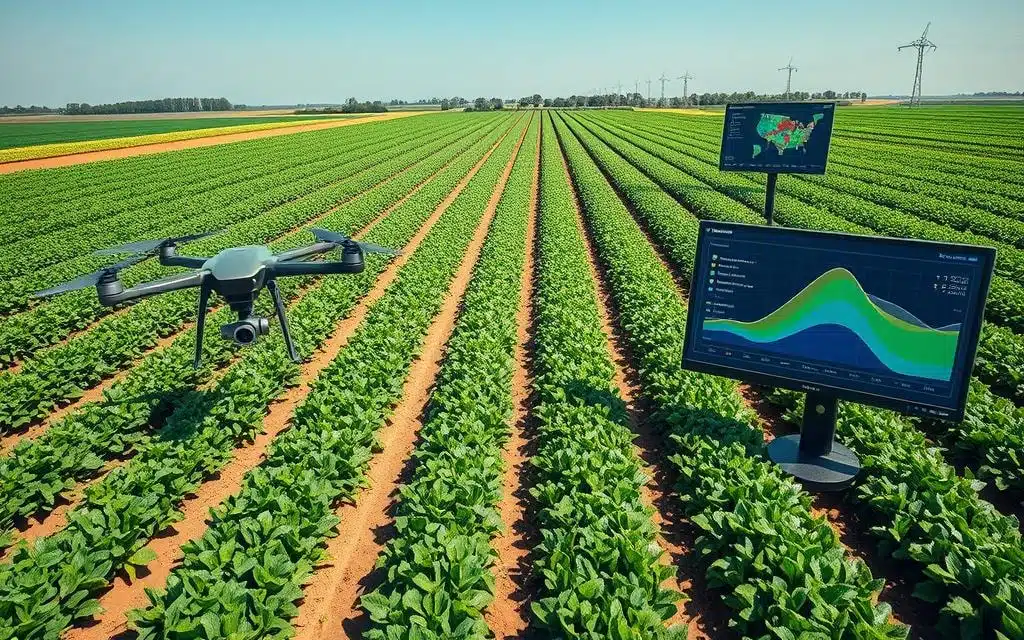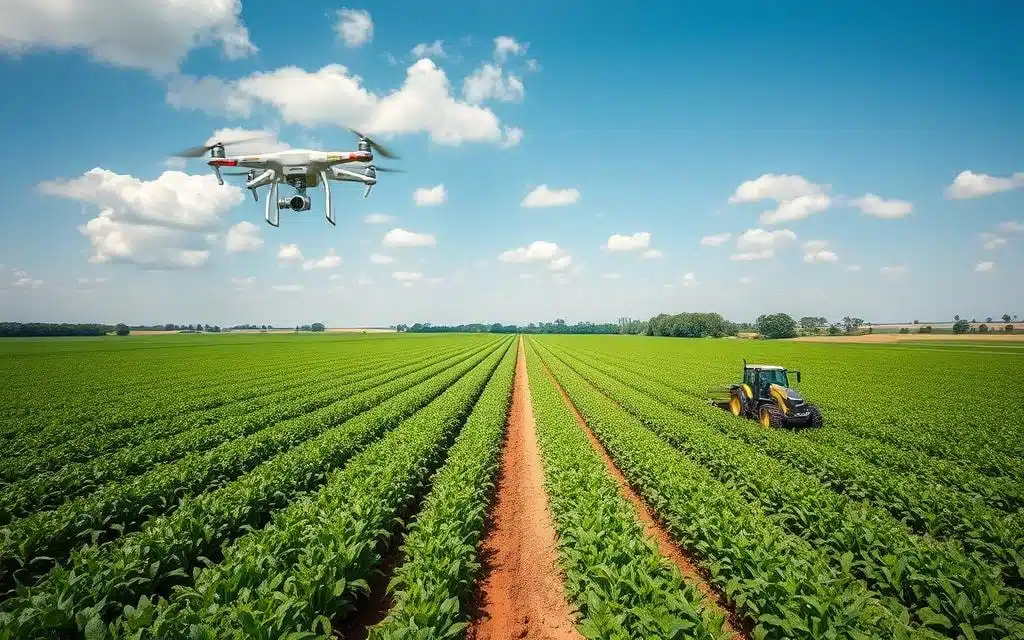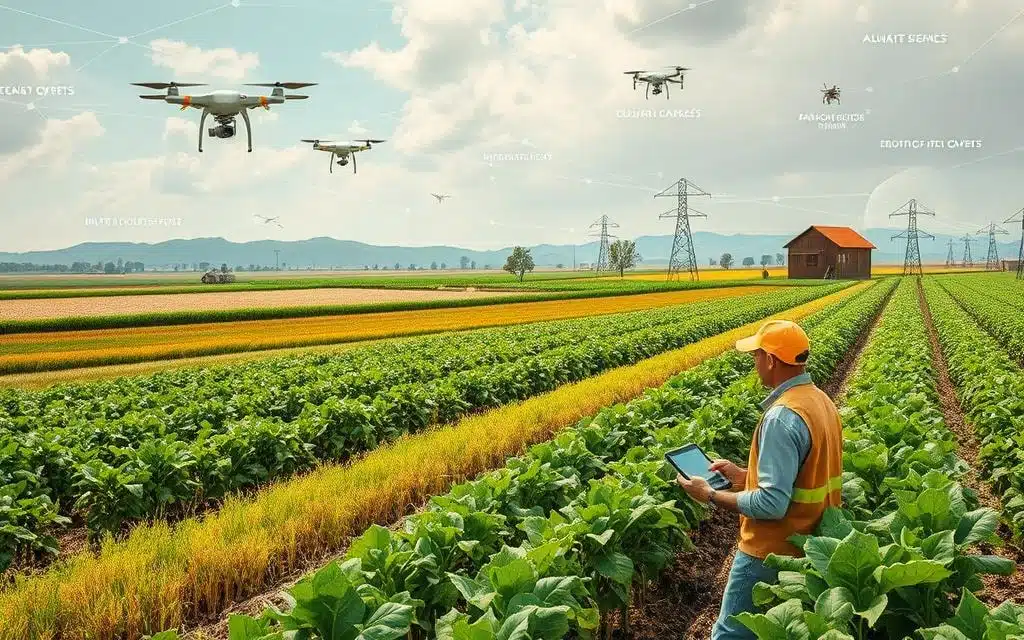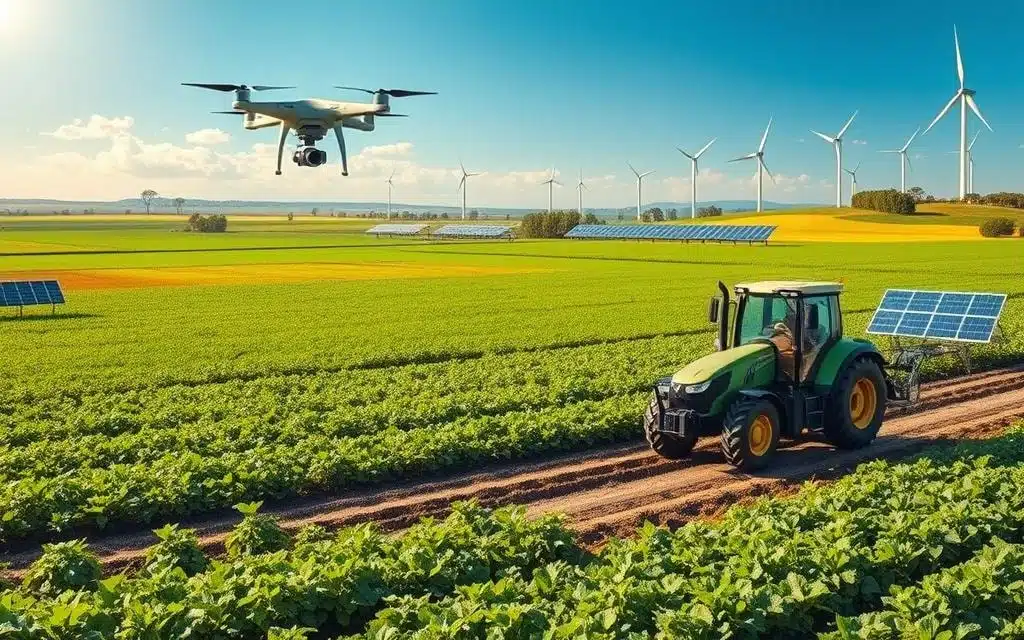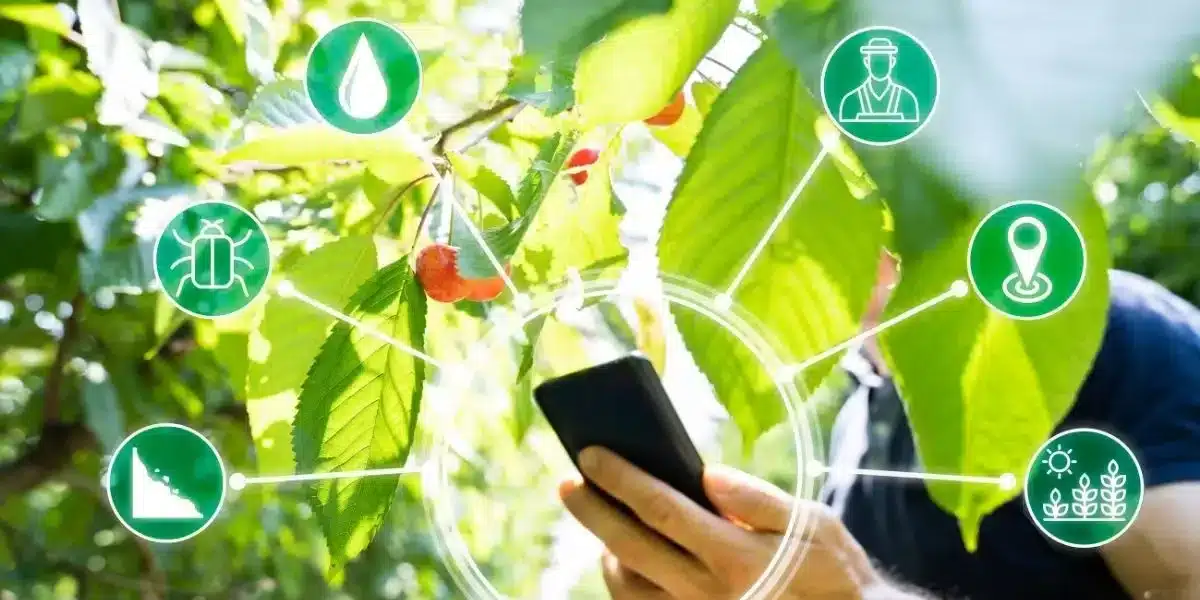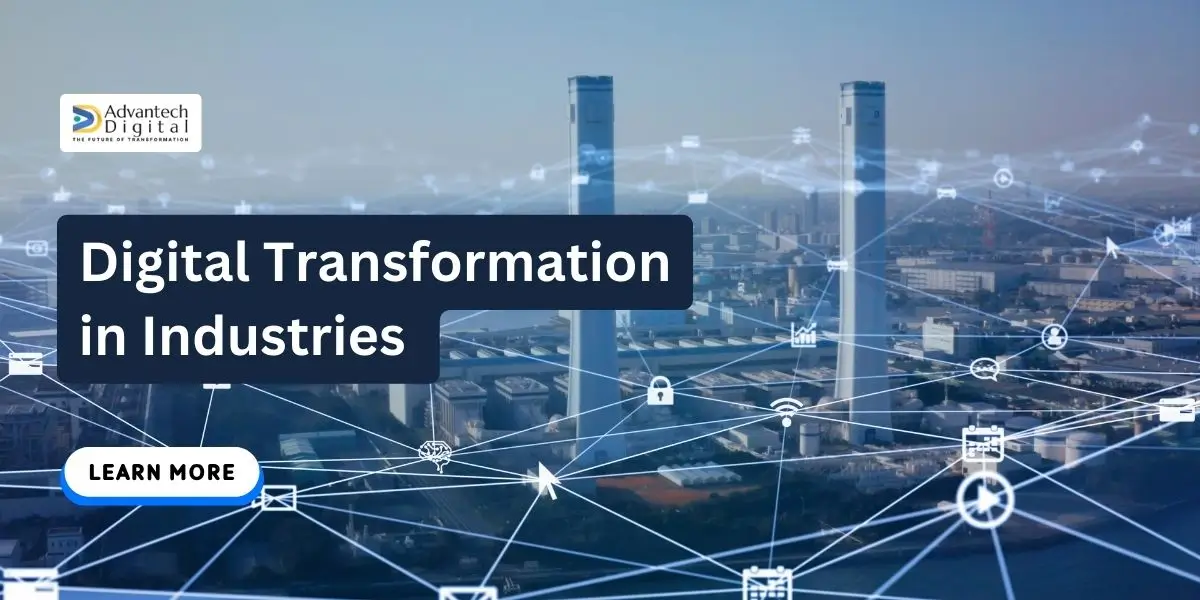The digital transformation in agriculture sector is changing rapidly. Sustainability and efficiency are now crucial. Digital transformation is reshaping how we grow food and support communities.
Digital transformation in agriculture harnesses technology and data-driven insights. It uses precision farming, smart agriculture, and agricultural IoT. These tools help farmers make better decisions based on real-time data.
This new approach increases yields and reduces waste. It creates a more sustainable future for farming. Traditional methods are no longer enough.
Digital transformation revolutionizes farming practices. Precision agriculture optimizes resource use. Agricultural technology, including smart farming systems, monitors crop health in real-time.
These technologies create a more efficient agricultural landscape. Data analytics and AI provide farmers with valuable insights. This allows for informed decisions that boost productivity. At the same time, it minimizes environmental impact. Farmers can now do more with less.
Key Takeaways
-
Digital transformation in agriculture is revolutionizing farming practices, leading to increased efficiency and sustainability.
-
Precision farming techniques enable farmers to optimize resource allocation and reduce waste.
-
Smart agriculture systems provide real-time monitoring of crop health, allowing for proactive decision-making.
-
Agricultural IoT devices collect valuable data that can be analyzed to gain insights and improve farming operations.
-
Embracing digital transformation is crucial for farmers to remain competitive and meet the growing demands of a growing population.
Understanding Digital Transformation in Agriculture
Digital transformation is changing farming operations. Cutting-edge technologies are improving precision and efficiency in agriculture. Digital farming tools, software, and robotics are driving this industry shift.
What is Digital Transformation in Agriculture?
In agriculture, digital transformation integrates IoT, sensors, and data analytics into the farm production system. These technologies enable data-driven farming practices. The goal is to optimize resources and boost crop yields.
Key Technologies Driving Change
Several technologies are leading the agricultural digital transformation:
-
Sensors: Continuous monitoring of environmental factors like temperature, humidity, and soil moisture aids in optimal crop growth.
-
Drones: High-resolution cameras identify areas of concern in crops, such as pest infestations or nutrient deficiencies, enabling precise interventions.
-
Artificial Intelligence: AI algorithms analyze vast amounts of agricultural data to provide insights, such as predicting optimal planting or harvesting times based on historical weather patterns.
-
Wearable Devices: Sensors for livestock management provide early detection of diseases and improve animal welfare by monitoring health and behavior.
The Importance of Data in Agriculture
Data is crucial in agriculture’s digital transformation. Farmers collect and analyze various types of information. This data helps them make informed decisions.
|
Data Type |
Description |
|---|---|
|
Land Data |
Soil type, topography, and fertility |
|
Crop Data |
Crop variety, growth stage, and yield |
|
Livestock Data |
Animal health, behavior, and production |
|
Agronomic Data |
Fertilizer application, pest management, and irrigation |
|
Climate Data |
Temperature, humidity, rainfall, and weather patterns |
Protecting data sharing, sovereignty, and security builds trust in agriculture. Proper data management lets farmers optimize their operations. This contributes to a sustainable and productive future for farming.
The Impact of Digital Transformation on the Agriculture Industry
The agriculture industry is undergoing a significant transformation with the integration of digital technologies. Digital transformation is revolutionizing the way farmers produce, process, and distribute food. By leveraging advanced tools such as artificial intelligence, precision agriculture, and farm automation, farmers can enhance farm productivity, reduce waste, and promote sustainable agricultural practices.
Artificial Intelligence Impact
Artificial intelligence (AI) plays a crucial role in analyzing vast amounts of data to provide actionable insights. For instance, AI algorithms can predict optimal planting and harvesting times based on historical weather patterns, helping farmers make informed decisions. Precision agriculture techniques, such as GPS-controlled machinery and sensor systems, enable farmers to apply water, fertilizers, and pesticides more accurately, reducing resource wastage and environmental impact. Farm automation, including robotic harvesters and self-driving tractors, addresses labor shortages and increases operational efficiency.
Overall, digital transformation is driving the agriculture industry towards a more efficient, cost-effective, and sustainable future.
How Digital Transformation Affects Carbon Emissions in Agriculture
Digital transformation is also having a positive impact on carbon emissions in agriculture. The adoption of precision agriculture and farm automation reduces the need for manual labor and machinery, leading to lower greenhouse gas emissions. For example, precision irrigation systems ensure that water is used efficiently, minimizing runoff and reducing the energy required for pumping.
Moreover, digital technologies enable farmers to optimize their use of natural resources, such as water and fertilizers. By using data from sensors and IoT devices, farmers can apply these resources precisely where needed, reducing waste and minimizing environmental impact. This targeted approach not only conserves resources but also contributes to a reduction in carbon emissions associated with agricultural activities.
In essence, digital transformation is helping farmers adopt more sustainable practices that are better for the environment.
Benefits of Digital Transformation for Farmers
Digital transformation in agriculture offers numerous benefits for farmers. It optimizes operations, cuts costs, and enables data-driven decisions. Farmers can boost efficiency through precision agriculture, IoT solutions, and data analytics.
Increased Efficiency & Productivity
Digital farming tools are changing how farmers manage crops and livestock. A recent survey shows 79% of farmers use digital solutions to improve operations. These tools include global positioning systems (GPS)-controlled machinery, sensor systems, and satellite imagery.
Adoption rates vary by region and farm size. Germany, France, and the U.S. lead in digital farming. In Japan, 60% of farmers still use traditional methods. However, experts predict robotics use will double in 5-10 years.
AI adoption is expected to triple in the same period. This growth shows the potential for increased efficiency in agriculture.
Cost Reduction Strategies
Digital transformation helps farmers cut costs. Precision agriculture techniques minimize water, fertilizer, and pesticide use. This approach maintains crop health while reducing expenses.
The FAO estimates pests cause 20-40% of global crop yield losses. Digital tools help farmers target specific problem areas. This targeted approach lowers overall pest control costs.
|
Technology |
Current Adoption Rate |
Expected Adoption Rate (5-10 years) |
|---|---|---|
|
GPS-controlled machinery |
High |
Very High |
|
Satellite imagery |
High |
Very High |
|
Robotics |
Low |
Moderate |
|
Artificial Intelligence (AI) |
Low |
Moderate to High |
Enhanced Decision-making
Data-driven decisions are a key benefit of digital farming. Farm data analytics provide insights into soil conditions and weather forecasts. By 2050, each farm may produce 4.1 million daily data points.
Bayer’s Climate FieldView operates in 23 countries across five continents. It collects over 250 layers of high-definition data. This platform generates billions of data points from subscribed fields.
AI is highlighted as a core technology in driving the digital transformation of agriculture, enabling data-driven decisions, increased productivity, reduced costs, and sustainable farming practices.
Farmers want user-friendly tech and better training for digital tools. They also need simpler data presentation. Meeting these needs will speed up digital adoption in agriculture.
Smart Farming: The Future of Agriculture
Agriculture is changing rapidly, with smart farming leading the way. We must feed 9.8 billion people by 2050 with less land. Smart farming offers solutions for a sustainable agricultural future.
It tackles issues like declining arable land and rising greenhouse gases. These innovative approaches promise to reshape farming practices worldwide.
What is Smart Farming?
Smart farming blends advanced technologies to boost agricultural processes. It uses precision farming, robotics, and AI to enhance decision-making. Farmers can reduce waste and increase productivity with these tools.
Precision agriculture techniques allow for targeted use of pesticides and fertilizers. This approach focuses on individual plants or animals for more efficient farming.
Technology Integration in Smart Farming
Various technologies work together to make smart farming successful. Here are some examples of how technology is changing agriculture:
-
Internet of Things (IoT): IoT helps farmers monitor individual animals and adjust their care. Smart greenhouses use IoT sensors to control climate, cutting costs and losses.
-
Drones and Aerial Imaging: Drones assess crop health, manage irrigation, and monitor fields. They capture various images, giving farmers insights into plant health and yield predictions.
-
Robotics and Automation: Self-driving tractors and robotic harvesters boost productivity. These tools address labor shortages and increase efficiency in farming operations.
The global smart farming market could reach $15.3 billion by 2025. This growth comes from increased use of precision agriculture tools.
GPS, remote sensing, and data analytics enhance farming practices. These technologies turn farm data into useful insights for better resource management.
|
Technology |
Benefits |
|---|---|
|
Precision Farming |
Increased crop yields, reduced pesticide and fertilizer use |
|
Agricultural Robotics |
Increased productivity, lower labor costs |
|
Farm Management Software |
Data-driven decision-making, resource optimization |
|
AI in Agriculture |
Improved efficiency, reduced waste, enhanced sustainability |
Smart farming is crucial for tackling future agricultural challenges. It combines precision farming, robotics, and AI to improve farming.
These technologies create a more resilient and sustainable food system. The future of agriculture looks bright with smart farming leading the way.
Key Technologies Transforming Agriculture
Digital tech is changing farming in big ways. New tools help farmers grow crops and care for animals better. Let’s look at some key technologies shaping farming’s future.
Internet of Things (IoT) Applications
IoT is a game-changer in precision farming. Sensors and devices collect real-time data on soil, temperature, and nutrients. This helps farmers make smart choices and use resources wisely.
With IoT, farmers can water crops just right and add nutrients where needed. They can spot problems fast and grow more food with less waste.
Drones and Aerial Imaging
Drones have become vital tools in modern farming. They take pictures that show crop health and growth patterns. Farmers use these images to find trouble spots and tend to crop better.
Drones also help with precise spraying of chemicals. This cuts down on pollution and saves money.
Artificial Intelligence in Agriculture
AI is changing how farmers use data and make choices. It looks at info from sensors, drones, and other sources. This helps farmers decide how to manage crops best.
AI can spot plant diseases and pests early. It also helps farmers use their resources better, leading to more crops and profit.
Robots, blockchain, and virtual reality are another exciting farm tech. These tools help solve big farming problems. They tackle labor shortages, climate change, and the need for eco-friendly practices.
Sustainable Agriculture Practices
Sustainable agriculture practices are essential for ensuring the long-term health and productivity of the agricultural sector. Digital agriculture is playing a critical role in promoting these practices by providing farmers with the tools and information they need to make informed decisions about their farming operations.
Digital technologies, such as remote sensing and data analytics, allow farmers to monitor soil health, crop growth, and weather conditions in real-time. This information helps them implement sustainable practices, such as crop rotation, cover cropping, and reduced tillage, which improve soil health and reduce erosion. Additionally, digital platforms facilitate knowledge sharing among farmers, enabling them to learn from each other’s experiences and adopt best practices.
By integrating digital agriculture into their operations, farmers can achieve higher productivity while maintaining the health of their land and resources.
Climate-Smart Agriculture and Its Benefits
Climate-smart agriculture is an approach to farming that takes into account the impacts of climate change on agricultural production. It involves the use of digital technologies, such as precision agriculture and farm automation, to optimize crop yields and reduce waste. For example, precision agriculture techniques allow farmers to apply inputs like water and fertilizers more efficiently, reducing the environmental footprint of their operations.
Climate-smart agriculture also promotes sustainable practices, such as conservation agriculture and agroforestry. Conservation agriculture involves minimal soil disturbance, maintaining soil cover, and crop rotation, which enhance soil health and reduce greenhouse gas emissions. Agroforestry integrates trees and shrubs into agricultural landscapes, improving biodiversity and carbon sequestration.
By adopting climate-smart agriculture, farmers can enhance their resilience to climate change, improve soil health, and contribute to global efforts to reduce greenhouse gas emissions.
Case Studies: Success Stories in Digital Agriculture
Digital transformation in agriculture has created remarkable success stories globally. Farmers now use precision farming, agricultural robotics, and farm data analytics. These AgTech innovations optimize operations and boost profitability.
Precision Agriculture in Action
Precision agriculture has changed how farmers manage crops. GPS, sensors, and drones collect data on soil health and weather conditions. This information helps farmers make smart decisions about resource allocation.
John Deere’s autonomous machinery has improved productivity by 15%. WiseConn’s DropControl system reduced water usage by 30%. These technologies enhance water management in farmlands.
Sustainable Practices Enhancing Profitability
Digital agriculture increases yields and promotes sustainable practices. The World Economic Forum’s AI initiative in Telegana boosted agriculture exports by 9%. It improved food security and encouraged sustainable farming methods.
India’s Agtech ecosystem grew from 50 to 1000 startups between 2013 and 2020. This growth could increase farmer incomes by 25% to 35%.
UPL, an agrochemical company, uses technology for direct-to-farmer sales. This approach bypasses middlemen and retailers. SBI’s YONO Krishi App provides farmers with suitable financial products, reducing loan risks.
ITC’s e-Choupal network expanded direct-from-farm procurement over 20 years. This expansion has improved market connections for farmers.
These stories show the power of digital agriculture. Precision farming and AgTech innovations increase productivity and profitability. They also contribute to a more sustainable and resilient agricultural sector.
Digital Agriculture in India
India is a significant player in the global agriculture industry, and digital agriculture is playing a critical role in promoting agricultural development in the country. The integration of digital technologies is helping Indian farmers improve productivity, reduce costs, and adopt sustainable practices.
Digital agriculture tools, such as mobile apps and IoT devices, provide farmers with real-time information on weather conditions, soil health, and market prices. This information empowers farmers to make better decisions and optimize their operations. Additionally, digital platforms facilitate access to financial services, enabling farmers to secure loans and insurance more easily.
The adoption of digital agriculture in India is transforming the agricultural landscape, making it more efficient and resilient.
India’s Take on Digital Agriculture
The Indian government is actively promoting digital agriculture through initiatives such as the National Agriculture Innovation Agenda. This agenda aims to foster agricultural innovation and improve productivity through the use of digital technologies. For instance, the Soil Health Card Scheme provides farmers with detailed information on soil health and fertilizer use, helping them make informed decisions about crop management.
Additionally, the government is supporting farmers through various programs that provide access to digital tools and training. These initiatives are designed to enhance farmers’ digital literacy and encourage the adoption of modern agricultural practices.
By embracing digital agriculture, India is poised to achieve significant advancements in agricultural productivity and sustainability, ensuring a prosperous future for its farming community.
Challenges Faced in Digital Transformation
Digital transformation in agriculture faces several obstacles. Farmers often resist new technologies due to uncertainty. This resistance stems from limited digital literacy and poor internet connectivity in rural areas.
The adoption of new technologies in digital transformation can be challenging for farmers. They may hesitate until benefits are clear and risks are reduced.
High initial costs pose another hurdle for digital technology adoption. Small-scale farmers struggle to afford precision farming tools and IoT sensors. Limited programs exist to reward farmers for ecosystem services.
These programs often don’t cover the full costs of adopting new technologies. This leaves farmers to bear most of the financial burden.
Resistance to Change Among Farmers
Many farmers remain cautious about embracing smart agriculture. This resistance stems from various factors. These include lack of awareness and digital literacy challenges.
-
Lack of awareness and understanding of advanced technologies
-
Digital literacy challenges, particularly in rural areas
-
Concerns about data security and privacy
-
Uncertainty about the return on investment
Overcoming this resistance requires educating farmers about digital transformation benefits. Providing training and support is crucial for effective technology adoption.
High Initial Investment Costs
Implementing digital technologies in agriculture can be costly. Small-scale farmers often struggle with these expenses. Precision farming tools and IoT sensors can be particularly expensive.
Consider the following cost ranges for agricultural technologies:
|
Technology |
Cost Range |
|---|---|
|
Precision farming tools |
$10,000 – $50,000 |
|
IoT sensors |
$500 – $5,000 |
|
Drones for crop monitoring |
$1,000 – $10,000 |
To help farmers overcome these financial barriers, support is needed. Governments and private organizations should offer funding programs, subsidies, and other incentives.
These initiatives can encourage wider adoption of digital technologies in agriculture. This support is crucial for transforming the agricultural sector.
The Role of Government in Digital Transformation
Governments drive digital transformation goals & objectives through policies and funding. They aim to boost precision farming and smart agriculture. These efforts support farmers in adopting new technologies.
China targets a 15% agricultural digital economy by 2025. Challenges include an aging workforce and low digital literacy. Currently, the digital economy’s penetration in agriculture is 8.2%.
Policies Supporting Innovation in Agriculture
Governments are implementing various policies to support innovation in agriculture, such as:
-
Investing in research and development of new technologies
-
Providing incentives for farmers to adopt precision farming techniques
-
Promoting open data initiatives to streamline agricultural innovation
-
Collaborating with international organizations to align digital transformation efforts with global goals
The FAO aims to create 1,000 digital village hubs globally. They focus on rural transformation. Their DVI Readiness Assessment tool has been tested in over 30 villages.
Funding Programs for Farmers
Governments provide financial support to farmers through various programs. These helps overcome the high costs of new technologies.
|
Country |
Program |
Description |
|---|---|---|
|
United States |
Precision Agriculture Connectivity Act |
Provides $600 million to expand rural broadband access |
|
European Union |
Common Agricultural Policy (CAP) |
Supports farmers in adopting sustainable and innovative practices |
|
India |
AgriStack |
Aims to create a unified database for farmers to access government services and financial support |
These programs enable farmers to benefit from smart agriculture and precision farming. They help make farming more sustainable and profitable.
“Emerging digital technologies provide services like instant messaging, mobile apps, websites, and platforms for agriculture communities to share knowledge, advice, and access extension services.”
Digital transformation in agriculture is a government priority. This focus will lead to more innovative farming solutions. The result will be more efficient and sustainable practices worldwide.
Future Trends in Digital Agriculture
The future of digital agriculture is full of exciting possibilities. Technology advances and sustainable farming needs are driving innovation in agriculture. This new era brings fresh ideas to grow and use food better.
The Rise of AgTech Startups
AgTech startups are leading the digital revolution in farming. The US has 3,475 agritech startups, followed by the UK with 689 and Canada with 632. These companies use precision farming, AI, and IoT to boost crop yields and reduce waste.
The IoT market in agriculture is growing fast. It’s set to expand from $13.61 billion in 2022 to $33.57 billion by 2032. IoT devices with sensors help farmers check soil and crops from afar.
Predictions for the Next Decade
Several key trends will shape digital agriculture’s future. The global precision farming market may reach $34.01 billion by 2032. AI in agriculture could grow to $4.7 billion by 2028.
Demand for sustainable and organic food will keep rising. People are more aware of health and environmental issues. This drives the need for better farming methods.
-
The global precision farming market is projected to surpass $34.01 billion by 2032, up from $9.8 billion in 2022, with a CAGR of 13.30%.
-
The artificial intelligence market in agriculture is set to grow from $1.7 billion in 2023 to $4.7 billion by 2028, at a CAGR of 23.1%.
-
The demand for sustainably produced and organic food products will continue to rise, driven by growing health and sustainability awareness among consumers.
Digital twins and AI will change farming operations. They’ll offer detailed simulations and predictive analytics. Regenerative agriculture will gain popularity as farmers aim to improve soil health and biodiversity.
|
Technology |
Market Value (2022) |
Projected Market Value |
CAGR |
|---|---|---|---|
|
Smart Agriculture |
$15 billion |
$33 billion (2027) |
– |
|
Precision Farming |
$9.8 billion |
$34.01 billion (2032) |
13.30% |
|
IoT in Agriculture |
$13.61 billion |
$33.57 billion (2032) |
9.5% |
|
AI in Agriculture |
$1.7 billion (2023) |
$4.7 billion (2028) |
23.1% |
AgTech innovations are shaping farming’s future. Teamwork between policymakers, industry leaders, and tech providers is key. It will help maximize digital benefits and tackle challenges in agriculture.
Conclusion: Embracing Change in Agriculture
Digital transformation in agriculture can revolutionize the industry. Precision farming, smart agriculture, and IoT help farmers overcome challenges. These technologies boost efficiency, cut costs, and improve decision-making.
Digital transformation has already shown impressive results. Farmers can achieve sustainable growth by adopting these innovative solutions.
Summary of Key Points
Data-driven approaches are crucial in modern agriculture. IoT, drones, and AI play vital roles in transforming farming practices. Collaboration among stakeholders is essential for successful implementation.
Case studies show tangible benefits of embracing change. Farmers experience increased profits, reduced crop losses, and improved yields. Smart tools empower farmers with accessible, user-friendly solutions.
Call to Action for Farmers and Stakeholders
Farmers and stakeholders must embrace the digital revolution. Invest in precision farming and adopt data-driven decision-making processes. Leverage smart agriculture solutions to build a sustainable future.
Collaboration is key to addressing challenges and fostering innovation. Farmers, tech providers, and researchers must work together. This ensures an inclusive and equitable digital transformation.
By harnessing digital technologies, we can feed a growing population. We’ll also preserve our planet’s resources for future generations. Let’s work together to create a resilient agricultural sector.
FAQ
What is digital transformation in agriculture?
Digital transformation in agriculture uses advanced technologies to improve farming practices. It integrates IoT, sensors, and data analytics to boost productivity. This shift aims to optimize processes and promote sustainable farming methods.
How can data help in agricultural decision-making?
Data provides valuable insights for informed farming decisions. It helps optimize operations, reduce costs, and enhance overall farm performance. However, safeguards for data sharing and security are crucial to build trust.
What are the benefits of adopting digital technologies in farming?
Digital technologies offer many benefits to farmers. These include increased efficiency, cost reduction, and improved decision-making capabilities. They also enhance animal welfare, working conditions, and competitiveness. Farmers can optimize production and achieve sustainable outcomes using precision agriculture and farm management software.
What is smart farming, and how does it integrate with digital technologies?
Smart farming combines various digital technologies into comprehensive management solutions. It uses AI, remote sensors, and intelligent farming systems. This approach helps farmers make data-driven decisions and optimize resource use.
What are some key technologies transforming the agricultural industry?
Several cutting-edge technologies are revolutionizing agriculture. These include IoT for crop monitoring, drones for aerial imaging, and AI for data analysis. Precision irrigation systems and under-canopy robots also play important roles. These technologies help farmers increase efficiency and reduce environmental impact. They also address labor shortages in the agricultural sector.
Are there any real-world examples of successful digital transformation in agriculture?
Yes, many case studies show successful digital technology use in agriculture. Precision agriculture techniques have optimized resource use and reduced waste. Sustainable practices like site-specific input application have improved soil health and profitability.
What challenges do farmers face in adopting digital technologies?
Farmers may face several challenges when adopting digital technologies. These include resistance to change and high initial investment costs. The need for new skills and limited reward programs can also be obstacles. Concerns about data privacy, security, and interoperability can hinder widespread adoption of digital solutions.
How are governments supporting the digital transformation of agriculture?
Governments support agricultural digital transformation through various policies and programs. The European Union has prioritized investment in the food value chain. They offer research projects, deployment actions, and support through the Common Agricultural Policy. More efforts are needed to ensure inclusivity and trust in data sharing.
What does the future hold for digital agriculture?
The future of digital agriculture looks promising. AgTech startups are providing innovative solutions. AI, robotics, and IoT technologies are becoming more common in farming. We can expect more collaboration among policymakers, industry leaders, and technology providers. This will help maximize digitalization benefits and address challenges.
How can farmers embrace digital transformation for a sustainable future?
Farmers can unlock potential by adopting digital technologies. This can lead to increased productivity and reduced environmental impact. Collaboration among stakeholders is crucial for addressing challenges. Together, we can ensure an inclusive and sustainable future for agriculture in the digital age.

